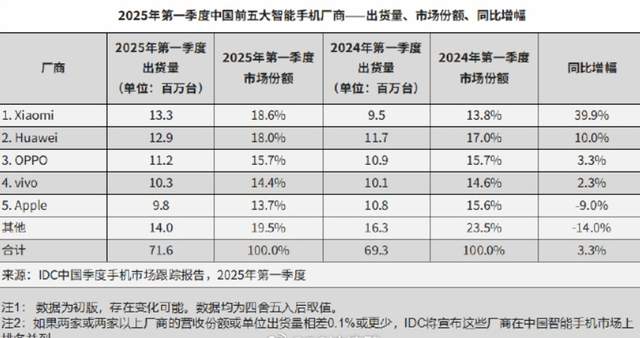Major Shakeup in Domestic Mobile Phone Market: Xiaomi Leads in 2025, Huawei Takes Second, Apple Drops to Fifth
![]() 04/16 2025
04/16 2025
![]() 542
542
Recently, the renowned market research firm IDC released data for the first quarter of 2025, revealing another significant shift in China's mobile phone market.
As illustrated below, Xiaomi firmly secured the top spot with impressive sales of 13.3 million units, marking a 40% increase and a substantial lead. Huawei closely followed, with OPPO, VIVO, and Apple trailing behind.

I. Market Dynamics Behind the Figures
Xiaomi's first-place position extends beyond the first quarter. According to the latest data on mobile phone activations in March, Xiaomi topped the list with 3.2437 million units, accounting for 17.98% of the market share and a year-on-year increase of 16.99%.
Huawei ranked second with a slight margin of 3.2296 million units but achieved the fastest growth rate, with a year-on-year increase of 19.87%. Notably, other mainstream brands experienced varying degrees of decline, with Apple slipping to fifth place, experiencing a 9.86% drop.

These data sets indicate a clear trend: China's domestic mobile phone market is transitioning from a "multi-power struggle" to a "dual-leader competition".
II. Xiaomi's Remarkable Growth: Four Key Pillars
1. Successful High-End Market Entry
Since announcing its push into the high-end market in 2020, Xiaomi's digital series has gradually shed the "cost-effective" label. By April 2025, sales of the Xiaomi 15 series surpassed 3.93 million units, underpinned by continuous investment in core areas like imaging chips and material processes.
2. Comprehensive Price Segment Coverage
Xiaomi's product lineup showcases a clear differentiation strategy: The Redmi series targets the 1000-3000 yuan price segment, catering to mass market needs with extreme cost-effectiveness, while Xiaomi's digital series and foldable models aim at the premium market above 4000 yuan. This "dual-track parallel" approach not only safeguards the basic market but also fosters synergy through technology spillover, such as applying flagship fast charging and screen technology to Redmi models. In Q1 2025, sales of the Redmi K70 series exceeded 5 million units, becoming a mid-range market hit.

3. Ecological Synergy Effect Emerges
The mass delivery of Xiaomi cars has emerged as a significant driver for brand upgradation. The success of the automotive business not only showcases Xiaomi's R&D and supply chain capabilities but also instills consumer confidence in its mobile phone technology. Additionally, the deep integration of mobile phones and cars within the interconnected ecosystem (e.g., seamless connection of infotainment systems) further enhances user loyalty.
4. Early Global Expansion Advantage
Since initiating its overseas strategy in 2014, Xiaomi's overseas sales now account for up to 75% of its total sales. In India and Southeast Asia, the Redmi series has long dominated the low-to-mid-range market, while in Europe, Xiaomi has gradually penetrated the high-end market through operator collaborations. This "localized operation + flexible pricing" strategy has fortified Xiaomi against domestic market fluctuations.

III. Future Market Structure in China: Huawei and Xiaomi Ascending, Others Declining?
Based on current trends, Xiaomi and Huawei are poised to dominate China's mobile phone market in the future.
For Huawei, its recovery hinges on two core strengths: Firstly, the ramping up of production capacity for its self-developed Kirin chips, alleviating previous supply chain bottlenecks; secondly, the maturity of the HarmonyOS ecosystem. As of 2025, HarmonyOS devices have surpassed 800 million, with cross-device experiences becoming a competitive differentiator, positioning Huawei for a potential return to its former glory.
For Xiaomi, maintaining its position will require continually solidifying its high-end image. While the average price of the Xiaomi 15 series has surpassed 4500 yuan, there is still a brand premium gap compared to Apple and Huawei. Enhancing product irreplaceability through technological innovation (e.g., implementing AI large models on mobile phones) will be Xiaomi's next challenge.

Other brands like vivo and OPPO must be wary of the risk of 'mediocrity'—their products are balanced but lack memorable breakthroughs. Meanwhile, Apple faces questions about its lack of innovation. If it fails to swiftly adapt to local Chinese demands (e.g., foldable screens, on-device AI), its market share may continue to shrink.








